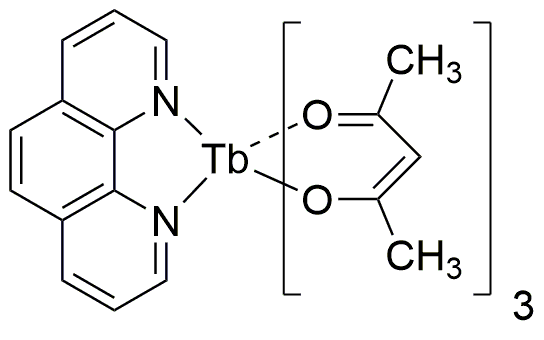Tris(acetylacetonato)(1,10-phenanthroline)terbium(III) is widely utilized in research focused on:
- Fluorescent Materials: This compound is used in the development of fluorescent materials for lighting and display technologies, enhancing brightness and color purity.
- Biomedical Applications: It serves as a luminescent probe in biological imaging, allowing researchers to visualize cellular processes with high sensitivity.
- Photonic Devices: Employed in the fabrication of photonic devices, it contributes to the advancement of optical communication technologies by improving signal quality.
- Environmental Sensing: This chemical is utilized in sensors for detecting pollutants, providing a reliable method for monitoring environmental health.
- Research in Coordination Chemistry: It plays a significant role in studies of coordination compounds, helping scientists understand complex interactions in various chemical systems.
General Information
Properties
Safety and Regulations
Applications
Tris(acetylacetonato)(1,10-phenanthroline)terbium(III) is widely utilized in research focused on:
- Fluorescent Materials: This compound is used in the development of fluorescent materials for lighting and display technologies, enhancing brightness and color purity.
- Biomedical Applications: It serves as a luminescent probe in biological imaging, allowing researchers to visualize cellular processes with high sensitivity.
- Photonic Devices: Employed in the fabrication of photonic devices, it contributes to the advancement of optical communication technologies by improving signal quality.
- Environmental Sensing: This chemical is utilized in sensors for detecting pollutants, providing a reliable method for monitoring environmental health.
- Research in Coordination Chemistry: It plays a significant role in studies of coordination compounds, helping scientists understand complex interactions in various chemical systems.
Documents
Safety Data Sheets (SDS)
The SDS provides comprehensive safety information on handling, storage, and disposal of the product.
Product Specification (PS)
The PS provides a comprehensive breakdown of the product’s properties, including chemical composition, physical state, purity, and storage requirements. It also details acceptable quality ranges and the product's intended applications.
Certificates of Analysis (COA)
Search for Certificates of Analysis (COA) by entering the products Lot Number. Lot and Batch Numbers can be found on a product’s label following the words ‘Lot’ or ‘Batch’.
Número de catálogo
Número de lote/lote
Certificates Of Origin (COO)
This COO confirms the country where the product was manufactured, and also details the materials and components used in it and whether it is derived from natural, synthetic, or other specific sources. This certificate may be required for customs, trade, and regulatory compliance.
Número de catálogo
Número de lote/lote
Safety Data Sheets (SDS)
The SDS provides comprehensive safety information on handling, storage, and disposal of the product.
DownloadProduct Specification (PS)
The PS provides a comprehensive breakdown of the product’s properties, including chemical composition, physical state, purity, and storage requirements. It also details acceptable quality ranges and the product's intended applications.
DownloadCertificates of Analysis (COA)
Search for Certificates of Analysis (COA) by entering the products Lot Number. Lot and Batch Numbers can be found on a product’s label following the words ‘Lot’ or ‘Batch’.
Número de catálogo
Número de lote/lote
Certificates Of Origin (COO)
This COO confirms the country where the product was manufactured, and also details the materials and components used in it and whether it is derived from natural, synthetic, or other specific sources. This certificate may be required for customs, trade, and regulatory compliance.


